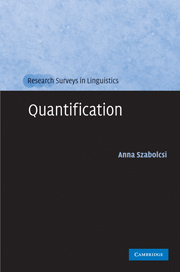Book contents
- Frontmatter
- Contents
- List of figures
- List of tables
- Acknowledgements
- 1 What this book is about and how to use it
- 2 Generalized quantifiers and their elements: operators and their scopes
- 3 Generalized quantifiers in non-nominal domains
- 4 Some empirically significant properties of quantifiers and determiners
- 5 Potential challenges for generalized quantifiers
- 6 Scope is not uniform and not a primitive
- 7 Existential scope versus distributive scope
- 8 Distributivity and scope
- 9 Bare numeral indefinites
- 10 Modified numerals
- 11 Clause-internal scopal diversity
- 12 Towards a compositional semantics of quantifier words
- Notes
- Bibliography
- Index
9 - Bare numeral indefinites
Published online by Cambridge University Press: 05 June 2012
- Frontmatter
- Contents
- List of figures
- List of tables
- Acknowledgements
- 1 What this book is about and how to use it
- 2 Generalized quantifiers and their elements: operators and their scopes
- 3 Generalized quantifiers in non-nominal domains
- 4 Some empirically significant properties of quantifiers and determiners
- 5 Potential challenges for generalized quantifiers
- 6 Scope is not uniform and not a primitive
- 7 Existential scope versus distributive scope
- 8 Distributivity and scope
- 9 Bare numeral indefinites
- 10 Modified numerals
- 11 Clause-internal scopal diversity
- 12 Towards a compositional semantics of quantifier words
- Notes
- Bibliography
- Index
Summary
Two previous chapters have already discussed aspects of the semantics of unmodified numeral indefinites that they share with other plurals: Chapter 7 focused on existential scope and Chapter 8 on distributive scope. The present chapter turns to aspects that specifically have to do with the presence of the bare numeral. Modified numeral expressions have overall different properties and are discussed in the next chapter.
§9.1 starts by situating numerical quantifiers in the broad landscape of DP types and their internal structures. §9.2 surveys the issues surrounding the ‘at least’ vs. ‘exactly’ interpretations. The next two sections are both concerned with the cardinal vs. individual readings of numeral phrases. §9.3 traces this ambiguity to two quantificational layers in numeral phrases (the so-called “split scope” analysis) and presents the ambiguity as a scope ambiguity vis-à-vismodal operators; §9.4 draws attention to the morpho-syntactic correlates of these interpretations, as reflected in gender/number agreement in French and Russian. It also introduces the split DP hypothesis, according to which D and NP do not start out as a DP constituent in syntax. (For an overview of the syntax of quantified phrases with an emphasis on Germanic and Romance, see Cardinaletti and Giusti 2006.)
The flexible DP hypothesis
Reinhart (1997) and Winter (2000, 2001) spell out the relation between the choice-functional analysis and the internal structure of DP. Specifically Winter assumes that the expressions traditionally classified as determiners occur in DPs in three different locations, and proposes the flexible DP hypothesis.
- Type
- Chapter
- Information
- Quantification , pp. 141 - 160Publisher: Cambridge University PressPrint publication year: 2010

